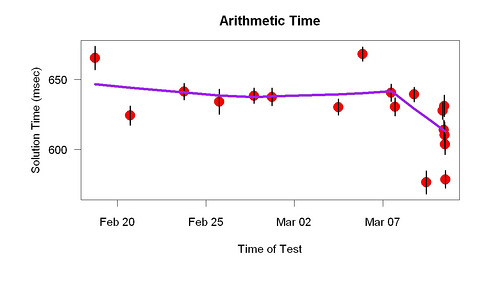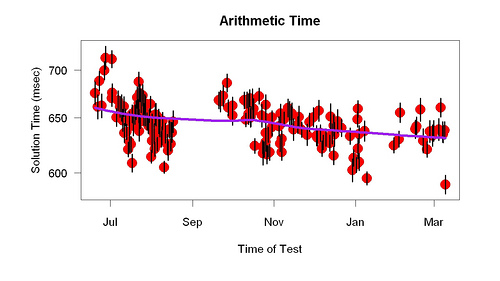Alexandra Carmichael is one of the founders of CureTogether.com, whom I met at a Quantified Self meeting last year. A few days ago, she left an interesting comment on one of my posts:
I practice random acts of kindness, with a goal of helping at least 10 people a day (and at least 1 person I don’t know). I find this helps my mood toward the end of the day, when it is most likely to fall – no matter what else has happened that day, at least I’ve helped 10 people.
I asked her about it:
SETH Where did the idea come from?
ALEXANDRA It goes all the way back to my grandparents being Scout leaders – I was never in the Scouts myself but I observed how helpful and supportive they always were. Then during my university years when I was forming my life philosophy, I got to attend an incredible lecture by Jane Goodall. Her organization Roots & Shoots inspires people around the world to give back to the earth, animals, and people around them, with her amazing presence and the quote “Every individual can make a difference.” Service learning is also one of the things we thread into homeschooling our two daughters, along with design, simple living, and non-violent communication.
The specific goal of helping 10 people a day started last summer during a goal-setting weekend. I was curious to see if formalizing and quantifying something I had been doing in a fuzzier way would make a difference in my life, if measuring acts of kindness would result in an increased number of acts, or more friends, or help me with my chronic depression – plus I love quantifying things!  I don’t find it necessary to actually record how many people I help in a day, but I keep a rough running tally in my head as I go through the day to make sure it’s at least 10 – my kids like to help with this count too.
I don’t find it necessary to actually record how many people I help in a day, but I keep a rough running tally in my head as I go through the day to make sure it’s at least 10 – my kids like to help with this count too.
SETH What are some examples of these acts?
ALEXANDRA I do a lot of different things. If I get extra free tickets to events or conferences, I will pass them along to people who I think would love to go; I will offer to take a picture of a tourist family where one person inevitably gets left out behind the camera; I will connect people who I think would benefit from knowing each other; I will take two hours to listen and hug and support a child who is having a hard time learning a new skill; I will answer a newbie entrepreneur’s questions about how to get started in business or help them spread their message; I will help coordinate gatherings that I believe in (such as Quantified Self); I will hold the door for someone. It can be anything really, no matter how small.
SETH How have people reacted when you tell them about this?
ALEXANDRA The most frequent reaction is “That sounds too challenging to do every day – 10 people? Why not 1 or 2?” The second most frequent reaction is “You are inspiring me to make positive changes in my own life.” My answer to both is “I love helping people!”
SETH What have you learned?
ALEXANDRA if you help people, without wanting anything in return, you get help when you need it – often surprising help, and often more than you gave. I learned that helping people seems to make them like you more, so my number of online friends has skyrocketed (1500 on Twitter, 800 on Facebook, 500 on LinkedIn) – but close “in person” friends I choose to limit to a handful because of my tendency to get overwhelmed by frequent or shallow social situations. I learned that helping people does help with depression, because (a) you have something else to focus on outside of yourself and (b) you go through the day with an expectant air of wonder at who will be the next person you can help. I also learned that helping 10 people a day is really not a lot, and I often wind up helping 20 or more people in a day. Of course, this is only from my perspective – I can’t guarantee that all of these people actually feel helped, I just know that I tried to help.
SETH When you say “if you help people, without wanting anything in return, you get help when you need it – often surprising help, and often more than you gave” I’m not sure I understand. Can you give some examples?
ALEXANDRA It’s not so much that the people I help help me in return, but more that by spreading goodwill and being tuned in to what others need, I also became more aware of my own needs and started to feel a greater sense of self-worth, like I deserved to have my needs met. This is not something I was taught growing up, and I went through two bouts of major postpartum depression without asking for or getting the support I needed. I feel much more open about my needs now, which perhaps makes it easier for others to help me. So the change was more in me than in others.
In terms of specific examples, when I learned that I have a Tourette’s spectrum disorder, and tweeted that, I made an incredible new friend who has been through similar neurological issues, and who in our conversations of support and empathy has helped me more than I can ever thank him for. Also, when I decided to find some consulting work to support my family while we build CureTogether, a very welcoming door opened (soon to be made public), and offered me basically a dream position. I guess I needed to learn to ask for and accept help as well as to give it.
SETH Thanks, Alexandra. It’s especially interesting that helping others raised your feeling of self-worth. I wouldn’t have guessed it would have that effect.

